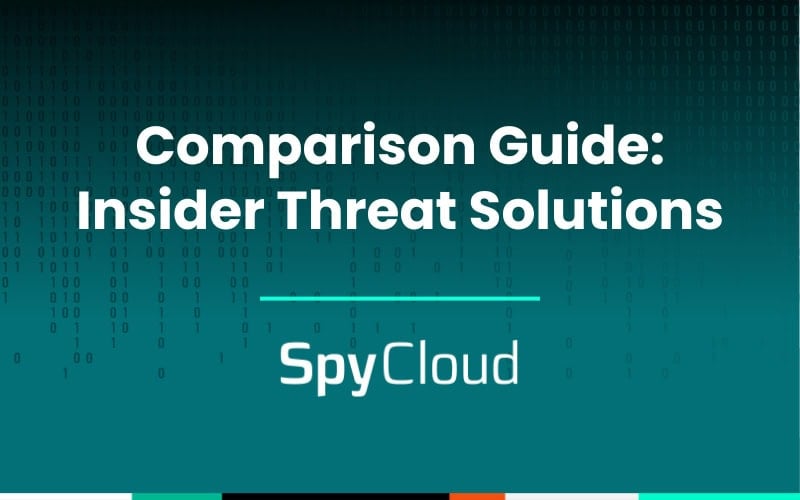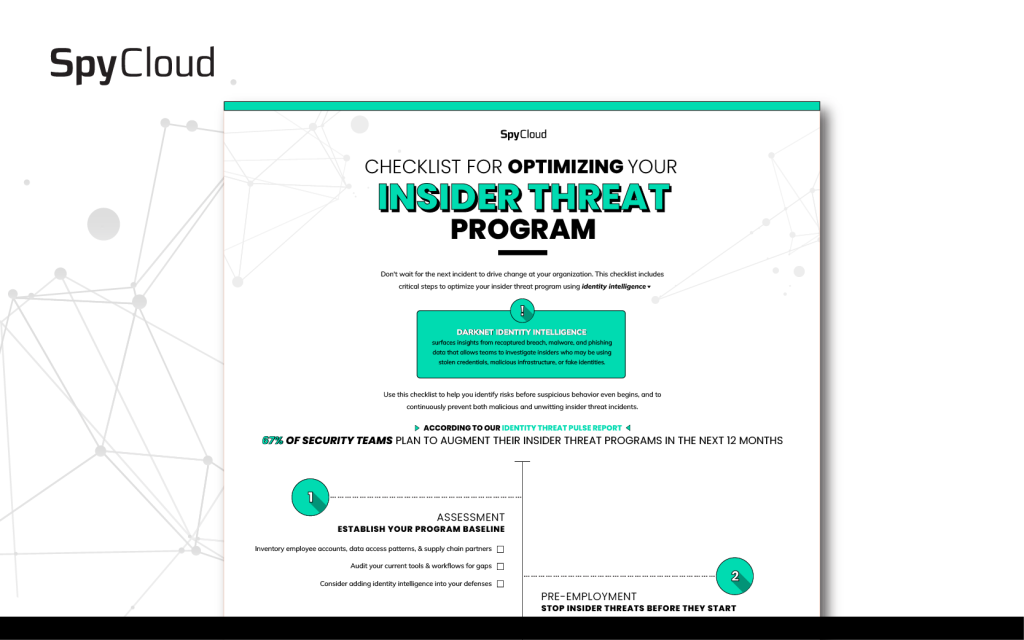Choosing the right tools to detect insider threats
Insider threats made major headlines in 2025, in part due to the widely-publicized North Korean IT worker schemes that impacted most, if not all, of the Fortune 500. With insider threats now a mainstream attack vector, many security teams are planning to augment their defenses accordingly in the next year.
As with most approaches, multi-layering is very much at play when we talk insider threat detection. The most effective insider threat programs combine behavioral detection with identity intelligence to catch malicious and negligent insiders before they cause problems.
In this guide, we compare the leading insider threat detection methods – from traditional SIEM, UEBA, and DLP solutions to insider risk management and identity intelligence – to help you understand which tools may work best together to protect your specific organization from identity threats.
Quick comparison guide:
- SIEM: Often paired with UEBA for analyzing user activity baselines and collecting data from endpoints, servers, cloud services, and IAM, but unable to detect all hidden threats
- IAM: Fundamental for controlling access to sensitive resources, but requires input of risk signals to know when to shut down access
- UEBA: Great for detecting behavior after compromise, with some detection of initial signs of entry before a corporate device is compromised from phishing attacks
- DLP: Stops data exfiltration
- Insider risk platforms: Hybrid approach, but limited darknet visibility
- Identity intelligence: Proactively detects credential exposure in the criminal underground to protect against malicious insiders (ex. DPRK IT workers), negligent insiders (ex. password reuse), and unwitting insiders (ex. phishing victims)
Why detecting insider threats is difficult
Insider threats present unique detection challenges that traditional security tools struggle to address because:
- Different threats require different approaches. Insider threats may be malicious (disgruntled employees or criminals working on large-scale compromise like the DPRK remote IT worker fraud campaign), negligent, or unwitting (employees with compromised credential reuse or phishing victims opening up unauthorized access on their laptop).
- Tool overload creates noise without insight. Organizations often deploy multiple security solutions that generate thousands of alerts, but lack the context to distinguish every real threat from normal business activity.
- Exposure often happens before behavior changes. By the time suspicious behavior triggers your monitoring systems, identity and credential compromise already may have occurred. Traditional detection tools miss the critical window when threats first emerge in criminal underground markets.
64% of organizations have an established insider threat program, but few can screen for malicious insiders before hiring. High-profile schemes like North Korea’s fraudulent IT worker campaigns have exposed a critical blind spot: traditional tools can’t detect malicious insiders before they join your workforce. By the time behavioral monitoring kicks in, synthetics identities have already passed your background checks and gained access to sensitive systems.
SpyCloud’s identity intelligence reveals compromised identities and fake profiles before candidates join your team.
Understanding the strengths and limitations of each insider threat detection tool helps you optimize your existing insider threat program.
Insider threat solutions comparison table
Solution Type & Example Vendors | Alert Signal Quality | Detects Behavioral Threats? | Detects Evidence of Darknet Compromise? | Continuously Detects Exposure? | Proactive or Reactive? | Setup Complexity |
|---|---|---|---|---|---|---|
| SIEM Splunk, Microsoft Sentinel, Elastic | Low High alert volume; requires tuning and correlation to reduce false positives | Yes | No | No | Reactive | VERY HIGH Requires log aggregation, custom rules, and security expertise |
IAM Okta, Microsoft Entra ID, Active Directory | Moderate Alerts tied to account or policy changes; limited threat context | Limited | No | No | Mixed | MEDIUM Requires integration with existing identity infrastructure |
UEBA Exabeam, Splunk UBA, Securonix | Low Behavior-based models generate noisy signals needing manual review | Yes | No | No | Reactive | MEDIUM Requires 30-90 day behavioral baseline |
DLP Forcepoint, Proofpoint, Microsoft Purview | Low Frequent low-fidelity alerts; sensitive to benign user behavior | Yes | No | No | Mixed | HIGH Requires extensive policy configuration and tuning |
Insider risk Mimecast, Cyberhaven, Teramind | Moderate Some context-aware fidelity, but high tuning effort | Yes | No | Partial | Mixed | MEDIUM Requires endpoint deployment and policy setup |
SpyCloud | High Low volume, high-fidelity alerts validated by recaptured identity data | No | Yes | Yes | Proactive | LOW Operational in 30 minutes with API or SaaS deployment |
Top insider threat detection tools for 2026
SIEM platforms
SIEMs serve as the central nervous system for insider threat programs, collecting and correlating security events across your entire technology stack. They excel at pattern recognition across diverse data sources, making them ideal for detecting complex insider threat scenarios that span multiple systems and timeframes.
Advanced threat detection for large enterprises, Splunk correlates insider threat signals across enterprise data with custom analytics and deep integrations, and is ideal for teams already invested in Splunk’s ecosystem.

Microsoft Sentinel is a cloud-native SIEM tightly integrated with Microsoft 365 and Azure, offering built-in threat intelligence and automation, and is best for Microsoft-centric organizations looking for scalable insider threat detection within their existing infrastructure.
Scalable SIEM built on open-source Elastic Stack, offering fast log analysis and flexible deployments, best suited for cost-conscious teams managing large data volumes in hybrid environments.
Identity Access Management (IAM) solutions
IAM solutions provide the foundation for insider threat detection and prevention by controlling who has access to what resources and under what conditions. Strong IAM practices implement least-privilege access principles and continuous identity verification, making it harder for insider threats to access sensitive data and easier to detect when they try.

Okta Workforce Identity provides centralized identity and access management with broad app integration and adaptive authentication, which is great for enhancing visibility into user access behavior across applications.

Identity foundation for Microsoft cloud environments with conditional access and identity protection, which is best for hybrid organizations relying on Microsoft tools for access control and account compromise detection.
The core identity service for Windows environments, providing access control, group policies, and audit logging, a best fit for on-premises identity management.
User and Entity Behavior Analytics (UEBA) solutions
UEBA solutions establish behavioral baselines for users and identify deviations that could indicate malicious or compromised insider activity. These tools are particularly effective at identifying subtle behavioral changes that might indicate account compromise or malicious intent.
Behavioral analytics platform using machine learning to detect anomalies and visualize attack timelines, and is ideal for security teams needing detailed insider threat investigations and behavioral baselining.
Extends existing Splunk deployments with advanced behavior analytics and risk scoring, best for organizations wanting insider threat detection without new infrastructure.
Monitors AD for identity-based attacks and insider threats, with attack timelines, great for detecting credential misuse in Microsoft environments.
Data Loss Prevention (DLP) solutions
DLP solutions monitor, detect, and block sensitive data as it moves through networks, endpoints, and cloud applications. DLP tools excel at understanding data context and user intent, helping distinguish between legitimate user activities and potential data theft.
Protects communications with DLP and email security, detecting data exfiltration, and is best for securing collaboration channels in communication-heavy organizations.

Integrated governance and insider risk management within Microsoft 365, enabling adaptive data policies, ideal for teams already using Microsoft tools seeking seamless compliance and data protection.
Insider risk platforms
Specialized insider risk platforms combine multiple detection methods to provide comprehensive visibility into insider threats. These solutions typically integrate behavioral analytics, data monitoring, and user activity tracking to detect various types of insider risks.
Tracks data movement and user context to detect suspicious behavior, with real-time prevention, which fits organizations focused on proactive insider threat defense.

Provides file-level visibility into user activity to detect and respond to data risk, best for teams needing continuous monitoring of sensitive file interactions by employees.

Offers employee monitoring with forensic-grade visibility, well-suited for compliance-driven environments requiring comprehensive user activity oversight.
Identity intelligence solutions
Identity intelligence helps organizations detect and prevent insider threats by acting on the same stolen data criminals use to exploit identities. These solutions continuously monitor the criminal underground for exposed identity data and compromised credentials that could lead to follow-on attacks and insider threats. This proactive approach detects threats with evidence of compromise before suspicious behavior surfaces by identifying when employee identities are exposed through infostealer malware infection, phishing attacks, or third-party breaches.
SpyCloud detects insider threats others miss – before behavior changes – by continuously monitoring nearly 900 billion recaptured identity assets from the criminal underground to deliver evidence of compromise early. SpyCloud delivers automated identity-centric risk detection that exposes malicious insiders before they’re hired, so they never get the chance to weaponize their access. SpyCloud identifies compromised credentials and session data in near-real time and automates remediation across your workforce, contractors, and third parties.
Why identity intelligence closes the insider threat detection gap
Traditional tools used in insider threat programs excel at behavioral detection, but they share a critical blind spot: they can’t see identity compromise happening with applicants or employees in darknet data long before suspicious behavior shows up in your security stack before it becomes network access.
Behavior monitoring is inherently reactive. By the time suspicious activity triggers alerts, credentials and employee identities may have been compromised. Attackers use this window to establish persistence and plan their attacks. Furthermore, stolen sessions, when exploited by malicious actors, can effectively bypass multi-factor authentication (MFA) security measures.
Identity threat intelligence is proactive. SpyCloud continuously monitors the criminal underground where stolen identity data is traded, detecting compromise at the source before behavioral anomalies surface or criminals can launch targeted follow-on identity attacks.
So what’s SpyCloud’s role in optimizing your existing insider threat program?
- Early warning system: Detects credential exposure well before suspicious behavior appears, for both malicious and negligent insiders
- Automated remediation: Enables immediate response through integrations with IAM, SIEM, and SOAR platforms to shut down unauthorized access
- Complements insider threat platforms: No need to rip-and-replace your security tools; instead SpyCloud enhances existing SSO, IAM, SIEM, and DLP tools to detect hidden threats
Rather than replacing your existing tools, augment with SpyCloud provides early and critical evidence of identity compromise that informs how every other security solution in your stack operates.
Optimizing your insider threat program
For today’s landscape, an optimal insider threat detection program benefits greatly from identity intelligence alongside continuous identity verification, behavioral monitoring, and rigorous access controls. The most effective approach to detecting and preventing insider threats combines proactive identity intelligence to detect credential exposure, behavioral analytics to identify suspicious activity patterns, data loss prevention to monitor sensitive information handling, and strong access controls to limit blast radius of compromised accounts.
A robust insider threat program, informed by frameworks like Zero Trust, requires continuous visibility into identity risk. You’ll want to continually evaluate employee identities for compromise as their digital exhaust often reveals hidden indicators of risk.
FAQs
Detection identifies threats after they occur, while prevention stops them before damage happens. Most insider threat tools focus on detection through behavioral monitoring, while identity intelligence enables prevention by revealing compromise before malicious access occurs.
Behavior analytics establish user baselines and detect deviations, requiring suspicious activity to trigger alerts. Identity-based tools monitor external threat sources to detect credential compromise before any behavioral changes occur, providing earlier warning of potential threats.
Yes, SpyCloud is designed to enhance existing security stacks rather than replace them. SpyCloud integrates with SIEM, SOAR, IAM, and other platforms to provide external threat context that makes your existing insider threat tools more effective at distinguishing real threats from false positives.
Any industry handling sensitive data benefits, but financial services, healthcare, technology, and government organizations see particular value due to their high-value targets and strict compliance requirements. Organizations with remote workforces also benefit significantly from identity exposure monitoring.
Most enterprise insider threat solutions, including SpyCloud, support compliance with the NIST Cybersecurity Framework and ISO 27001 requirements. Identity intelligence specifically supports the “Identify” and “Detect” functions by providing external threat context for risk assessment and continuous monitoring.



